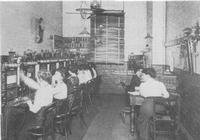


Chapter 8
I Part 1: Communications
i Before the Telegraph
ii Electrical Communication Before Federation
iii Federation to the End of the Second World War
iv Post-war and on to 1975
v 1975 ONWARDS
II Epilogue
III Part 2: Early Australian Computers And Computing
IV Acknowledgements
References
Index
Search
Help
Contact us

Federation to the End of the Second World War (continued)
The 1901 trunk line system was but embryonic, being restricted by cost and inherent transmission problems, with no inter-capital lines and indeed, few intrastate trunk lines of any length. However, commencing in 1905, a cheap extension was achieved by pairing telegraph wires and using a condenser telephone, or 'Phonophore' as it was known, to derive a voice circuit. As 16 Hz signalling could not be used, VF signalling, initially using howlers, an arrangement under which a VF signal was generated by a buzzer and received on a loudspeaker roughly tuned to the buzzer frequency, but later 135 Hz, with standard magneto interface conditions at the switchboard, was used. The long distance network grew slowly, with Sydney and Melbourne connected by a trunk line in 1907, Melbourne and Adelaide in 1914, Sydney to Brisbane was not completed until 1923, across the Nullabor to Perth in 1930, while Hobart had to wait for voice communications on the installation of the world's second submarine coaxial cable which was installed between Victoria and Tasmania, via King Island, in 1935.
Behind these bare statistics, an ongoing construction programme produced the result that by 1925, Australia had a mechanically well constructed network of poles and wires, lightly transposed to control crosstalk at voice frequencies, from Townsville down the east coast and across to Adelaide. Transmission problems, however, remained and, because of the high costs, the number of circuits on any route was minimal. By this time, however, developments overseas of carrier technology, based on the termionic valve, were about to enable Australian engineers to take the first steps, as will be described later, towards a new era of long distance communications in which transmission quality could be independent of distance, while costs in real terms would begin to fall, a process which has continued to the present time.
All early trunk lines used magneto signalling and special switching facilities were seldom provided, the trunk lines being terminated in the same way as ring down junctions. As the number of trunk lines increased, dedicated trunk exchanges began to appear in the Australian network, using imported equipment designed for delay working and with separate switching and recording positions. The circuits were essentially similar to those employed in a lamp-signalling branching-multiple magneto local exchange, with some refinements, including cord circuits, which allowed the operator to speak separately to either party, or to both, and the operator could ring the local subscriber without the assistance of the B operator. In small exchanges, with one or two positions to handle all traffic, local, junction and trunk, a special group of jacks and indicators was provided for trunks and junctions, an arrangement which is only now being brought to an end in the last stages of the country conversion programme. Some switchboards were made locally and there is a record of the Sydney workshops manufacturing exchanges for Wagga and Wollongong in 1920, but generally trunk equipment was imported.
People in Bright Sparcs - Todd, Sir Charles
 |
Australian Academy of Technological Sciences and Engineering |  |
© 1988 Print Edition pages 545 - 546, Online Edition 2000
Published by Australian Science and Technology Heritage Centre, using the Web Academic Resource Publisher
http://www.austehc.unimelb.edu.au/tia/535.html